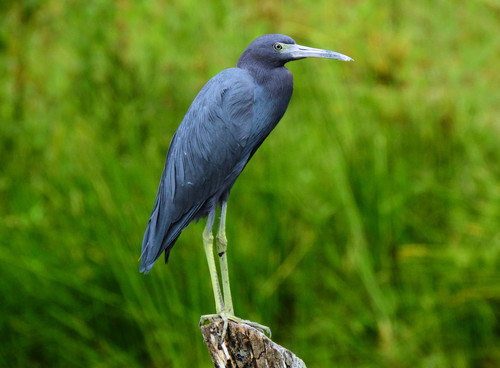
Little Blue Heron
The Little Blue Heron (Egretta caerulea) is a small, elegant heron found throughout the Americas. It is notable for its striking plumage transformation, starting life with all-white feathers and gradually transitioning to a slate-blue adult plumage. This species plays a crucial role in wetland ecosystems as a predator of small fish, amphibians, and invertebrates, helping to regulate prey populations. While not currently considered globally threatened, Little Blue Herons face localized threats from habitat loss and degradation.
56-76 cm
Length
100-110 cm
Wingspan
Least Concern
Conservation Status
Distribution
The Little Blue Heron is found in coastal and inland wetlands across the Americas. Its range extends from the eastern and southern United States, through Central America and the Caribbean, to South America, reaching as far south as Uruguay and Argentina. Some populations are migratory, with northern birds moving south for the winter.
Lifespan
The oldest recorded Little Blue Heron lived over 17 years. The average lifespan is likely shorter, around 7-8 years in the wild.
Little Blue Heron's Habitat
Habitat Types
Coastal marshes, Mangrove swamps, Freshwater wetlands, Lakes, Rivers, Ponds
Climate Zones
Tropical, Subtropical, Temperate
Adaptations
Little Blue Herons have long legs and toes, which are well-suited for wading in shallow water. Their slender bills are adapted for spearing small prey. They also possess specialized powder down feathers that disintegrate into a talc-like powder, used for preening and removing fish slime and oils.
Variations
While no subspecies are currently recognized, there can be some regional variations in size and plumage darkness, though these are not considered taxonomically distinct.
Appearance
Breeding Plumage
Adult breeding plumage is a dark slate-blue overall, with a purplish head and neck. Non-breeding adults have a duller blue body and a darker, less purplish head. Juveniles are entirely white, gradually molting into the adult plumage over their first year. This white juvenile plumage may provide camouflage and reduce aggression from adult herons.
Seasonal Feather Changes
During the breeding season, adults develop long, filamentous plumes on their head, neck, and back. Leg color can also change, becoming darker.
Sex Based Plumage Differences
Males and females have similar plumage, although males may have slightly more developed plumes during the breeding season.
Notable Features
Slender, dark bill, Long, dark legs, White juvenile plumage, Purplish head and neck in breeding adults
Diet and Feeding
Primary Foods
Small fish, Amphibians (frogs, tadpoles), Crustaceans (crayfish, shrimp), Insects, Small reptiles
Foraging Behavior
Little Blue Herons are primarily visual hunters, often standing still or slowly stalking prey in shallow water. They may also walk slowly, probing the mud or water with their bills. They are known to use a technique called 'foot stirring,' where they shuffle their feet to disturb prey hidden in the substrate.
Specializations
Their long, sharp bill is perfectly adapted for spearing fish and other small aquatic animals. Their long legs allow them to wade in deeper water than some other small heron species.
Seasonal Diet Variations
Diet can vary depending on prey availability. During the breeding season, they may consume more fish to meet the energy demands of raising young. In areas with seasonal fluctuations in water levels, their diet may shift to include more terrestrial insects when water levels are low.
Behavior
Social Structure
Little Blue Herons are often seen alone or in small groups, but they can form larger flocks, especially during migration or at roosting sites. They often nest colonially, sometimes in mixed-species colonies with other herons and egrets.
Communication
Croaking calls, Squawks, Bill snapping, Visual displays (plume raising, neck stretching)
Migration
Northern populations are migratory, moving south to warmer climates for the winter. The extent and timing of migration vary depending on the region. Some populations are resident year-round.
Territorial or Group Behaviors
During the breeding season, Little Blue Herons can be territorial, defending their nesting site from other herons. Outside of the breeding season, they are generally less territorial and may feed in close proximity to other individuals.
Conservation
Threats
Habitat loss and degradation (wetland drainage, pollution), Human disturbance, Climate change (sea-level rise, altered precipitation patterns), Pesticide contamination
Protection Programs
Wetland restoration projects, Protected areas (National Wildlife Refuges, state parks), Migratory Bird Treaty Act (in the United States)
Local National Laws
The Migratory Bird Treaty Act protects little blue herons, their nests, and their eggs in the US.
Population Trend
Stable
Population Estimates
The global population is estimated to be between 500,000 and 5,000,000 individuals.
Interesting Facts
Juvenile Little Blue Herons are entirely white.
This is unusual among herons and may help them blend in with flocks of white egrets, potentially reducing aggression from adult Little Blue Herons.
They sometimes forage alongside other heron species.
This mixed-species foraging can increase foraging efficiency, as different species may use different hunting techniques.
They can use their feet to stir up prey.
This 'foot stirring' behavior helps them flush out hidden prey from the mud or vegetation.
Faqs about Little Blue Heron
Why are juvenile Little Blue Herons white?
The white plumage of juveniles may help them avoid aggression from adult Little Blue Herons and may also allow them to forage more effectively with other white heron species.
What is the difference between a Little Blue Heron and a Snowy Egret?
Adult Little Blue Herons are blue-gray with a purplish head and neck, while Snowy Egrets are all white with black legs and yellow feet. Juvenile Little Blue Herons are white, but have greenish-yellow legs and a two-toned bill (dark tip, pale base), unlike the black bill and yellow feet of the Snowy Egret.
Are Little Blue Herons endangered?
Little Blue Herons are classified as 'Least Concern' by the IUCN, meaning they are not currently considered globally threatened. However, local populations may face threats from habitat loss and degradation.
Copyright @ Nature Style Limited. All Rights Reserved.
 English
English